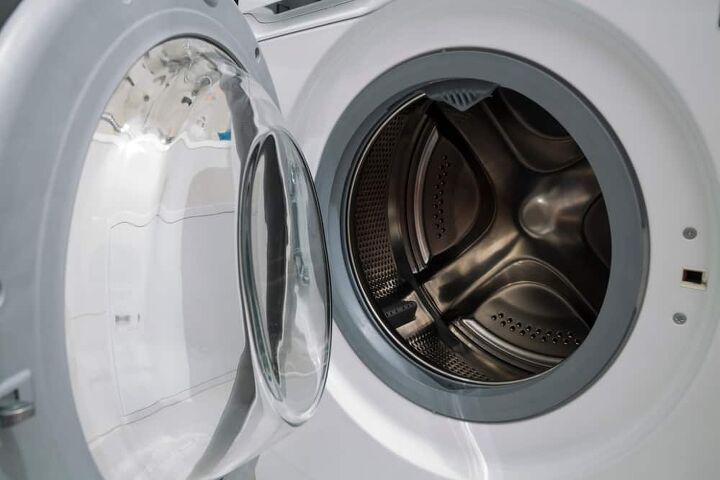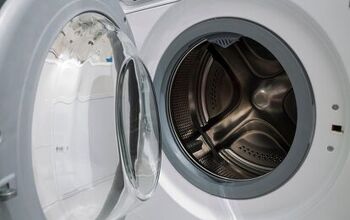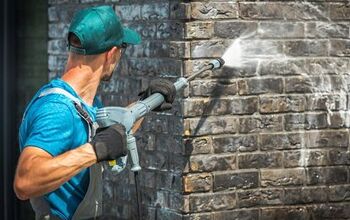LG Front Load Washer Leaking? (Possible Causes & Fixes)

LG front load washing machines are popular and are not known to have too many issues. However, every appliance has problems now and then. And LG front-loaders are no exception. They can have a leaking issue sometimes.
Determining the reason for the leaking can be difficult. It depends on where the water is coming from. If it is underneath the washing machine, it is either the drain filter, safety air vent, or the door. Other spots where leakage can occur include the inlet hoses, drain hose, the detergent dispenser, or the tub cover gasket.
To figure out what is going on, we can go through each spot where your washing machine may be leaking. There are usually several things you can do to find out more or to fix the issue. Before you mess with any of these, unplug the washing machine.
Related Content: Washing Machine Brands To Avoid | What Brand Of Washing Machine Is The Most Reliable? | Most Common Washing Machine Problems
Do You Need Appliance Repair Services?
Get free, zero-commitment quotes from pro contractors near you.

Drain Filter
Any kind of leak from the drain filter is caused by one of two reasons. Either the drain filter is not screwed on or sealed properly, or the drain hose cap is loose. Here are the steps that will fix the problem.
- Step One: Turn off and unplug the washing machine.
- Step Two: Find the service panel to the drain filter on the bottom left corner and open it up.
- Step Three: You can find the drain hose beside the drain pump. Unclip the hose and remove the cap from the hose to drain whatever water is still in the washing machine. Check the hose for cracks or damage.
Tip: Don’t pull out the hose too far or it will kink, causing it not to drain.
- Step Four: Drain the water into a bucket and then twist the pump filter to the left to remove it.
- Step Five: Use a soft bristle brush and warm water to clean the filter.
- Step Six: Make sure the filter opening and base are clean and there is no debris.
- Step Seven: Recap the drain hose and push it back into the washer.
- Step Eight: Put the drain pump filter back in and turn it to the right to secure it.
Safety Air Vent
If the water is coming from the safety air vent, this is usually caused by using too much detergent. These washing machines are made to use very little water and soap. Reduce the amount of detergent you use to under the normal line.
You should also make sure you are using high efficiency (HE) detergent. It is not recommended to use concentrated HE detergent since it leaves a residue buildup that can cause a leak in the air vent.
Also, if you use fabric softener, you should dilute it with water. Use a ratio of 50:50. And do not fill the softener dispenser to the max line. Otherwise, it can leak.
In addition, you have to clean your washing machine tub at least once a month. Use a tub cleaner made for this specific job. Although you can use vinegar or bleach, they do not remove the buildup as well.
Door Leaks
If the door is leaking, there is usually a problem with the gasket inside the door. If the gasket is not the problem, it may just be a buildup of residue, lint, or hair around the door. Take these steps to clean the door.
- Step One: Clean the gasket and door with one gallon of water mixed with bleach or vinegar. Do not use both. Just one of these.
- Step Two: Be sure to pull up the gasket to clean underneath it.
- Step Three: Clean the inside of the door from top to bottom and around the sides. Pay the most attention to the area where the door meets the frame.
- Step Four: Remove any residue, lint, or hair inside the bottom of the door.
- Step Five: Run a tub clean cycle on the washing machine to make sure the leak is fixed. If you need a gasket, you can replace it yourself or call the company for a repair.
Inlet Hoses
The inlet hoses are the most common spots where you will find the leak. To check the hose for leaks, follow these steps.
- Step One: Check to see if either of the hoses is wet.
- Step Two: Check them both to see if they are kinked anywhere, cracked, or have a hole.
- Step Three: Look at the spot where the hoses connect to the machine. If either is wet, tighten it up.
- Step Four: Check each one of the hoses all the way down looking for cracks, kinks, or holes.
- Step Five: Turn off the valve and remove each hose to check the rubber seal.
- Step Six: If any of the seals or hoses are damaged, replace them and check to see if the leak is fixed. If not, continue to step seven.
- Step Seven: It may also be a clogged inlet filter. You will have to remove the inlet hoses and check the filter on each one. Clean any buildup or other debris before putting them back in.
Drain Hose
If the drain hose leaks, it is usually from a hole or cracks in the hose, a clogged home drain, or the hose may not be connected properly.
- Step One: Check to see that the drain hose is connected to the back of the washing machine tightly. Look for cracks, kinks, or holes.
- Step Two: Check for any sign of an overflow like watermarks on the wall. If this is the case, it could be that the drain line is not a large enough diameter, or it may have a clog.
- Step Three: Check the entire hose for clogs. The easiest way to do this is to pour a gallon of water into the hose and make sure it is draining. If it is clogged, you can use a drain cleaner or call a plumber.
Detergent Dispenser
Any kind of leaks from the detergent dispenser is usually caused by an obstruction of some kind or too much detergent buildup. You will need to clean the detergent dispenser thoroughly to get all the buildup out of the entire dispenser.
- Step One: Pull the dispenser out and then press the tab between the softener and bleach compartments. Pull the tray out while you push on the tab.
- Step Two: Take the detergent dispenser apart and clean each piece individually. Use hot water and a soft-bristle brush. Be sure to get all of the debris out of the dispenser.
- Step Three: Put the dispenser back together and then push it back into the machine until it clicks.
Tub Cover Gasket
There is a gasket that provides the seal between the tub cover and the outer tub. It is what is used to stop water from leaking during the spin or wash cycles. Check the gasket by following these steps.
- Step One: Remove the front cabinet or panel.
- Step Two: Find the tub cover gasket. You will probably have to remove the tub cover to get to it.
- Step Three: Check the gasket for any signs of damage, cracks, or warping. Also, look for water stains in the area.
- Step Four: If the gasket looks old or damaged, change it with a replacement tub cover gasket by following the manufacturer’s instructions.
Do You Need Appliance Repair Services?
Get free, zero-commitment quotes from pro contractors near you.

Fixing The Leak In Your LG Washer
Related Questions
What if The Washing Machine Still Leaks?
According to some users, there is a part on the rubber hose that connects the tub to the pump called a mousetrap. This part has been known to break and cause leaking. To fix this, follow these steps.
- Step One: Pull the washer out and use vice grips to pull the clamp off the rubber hose going to the pump.
- Step Two: Remove the rubber hose.
- Step Three: Replace the rubber hose with the correct part.
- Step Four: Replace the clamp.
- Step Five: Push the washing machine back in.
If this is not the problem, check to make sure your washing machine is completely level. If the feet are not level, your washer can leak out from one of the hoses or the door. Set a level on top of your washing machine to make sure your washer is level. If not, adjust the feet until it is.
What Are Some Important Things to Know About LG Front Load Washing Machines?If this is your first time using a front load washing machine, you may be surprised about some of these things. For example, the wash times take a lot longer than a top load washing machine. The typical wash time for a front load washing machine is 70 to 120 minutes per load.
You can also use smaller loads if you want to. Although people typically buy the front load washing machine because it can wash larger loads, it is perfectly fine to wash a smaller load. However, because the clothes do not get agitated by a center agitator, the clothes may not get as clean if there are not enough clothes in there.
Another thing about the front load washing machines is the mold problem. Although they are better than they used to be, there is still a problem with mold and mildew in front loaders. But as long as you clean it regularly and follow the manufacturer’s instructions, it should be fine.
Check Out These Guides For Other Common Washing Machine Issues

I am a DIYer who loves writing about anything home-related. When I am not writing, you can find me studying for my PhD in Psychology, photographing nature, and swimming at the lake with my grandkids.
More by Patricia Oelze



























